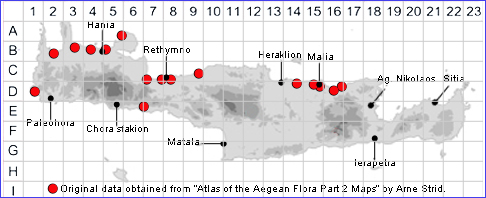
SPECIES DESCRIPTION
CENTAUREA SPINOSA subsp. SPINOSA
Family and Genus:- See- COMPOSITAE/Subgen. ACROLOPHUS/Sect.
Common Name:- None
Homotypic Synonyms:- Acosta spinosa.
Meaning:- Centaurea (Gr) Centaur, Centauros. The centaur Chiron was cured of a
hoof wound with this plant.
Spinosa (L) Spiny, with spines.
General description:- Perennial, forming neat, dense, hemispherical cushions up
to 100 cm in diam., intricately branched with twigs transformed into sharp spines.
Whole plant usually densely grey- or white-tomentose, occasionally greyish-green.
Stems:-
1) Up to 20 cm, much-branched, thick and spiny; white-tomentose.
Leaves:-
1) Appressed-grey-tomentose or glabrescent.
a) lower, undivided to pinnatifid, the segments spiny.
Flowers:-
1) Capitula, solitary.
2) Involucre, cylindrical to narrowly ovoid, 8-13 x 3-5 mm.
3) Appendage, of middle phyllaries triangular, pale brown, with 4-6 pairs of whitish
lateral fimbriae and a short apical mucro.
4) Florets, white, cream or occasionally pinkish; anther tube pale purplish.
Fruit:-
1) Achenes, 2-3 mm.
2) Pappus, deciduous.
Key features:-
1) Stems, usually much-branched and erect; spiny, woody above.
2) Capitula, comparatively small.
3) Bracts, usually with (3-)5-7 more or less distinct veins on the dorsal surface.
4) Pappus, deciduous.
Habitat:- Maritime sand and other coastal habitats. 0-700 m.
Distribution:- Endemic, Crete, Greece & Aegean. Grows on maritime sands
mostly on the northern coast of Crete.
Flowering time:- Mid-May to July(-Aug).
Photos by:-Steve Lenton
